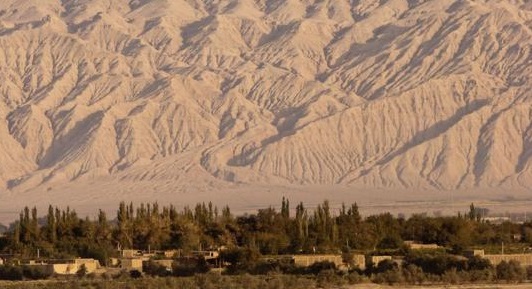导读:丝绸之路上一颗璀璨的明珠,因为暗渠的发明和修建而得以冉冉升起。

The air here has a matte gold colour, a reflection of the rugged, desert landscape. Far on the horizon, the peaks of the Tianshan Mountains shimmer, while in the foreground, China’s Turpan Basin is dotted with chunches, the Uyghur name for the small, square buildings where grapes are dried.
这里的空气似乎有着磨砂金的颜色,反射着崎岖的沙漠景观。遥远的地平线上,天山山脉的山峰闪着微光,而赫然出现在前方的是星罗棋布点缀着各式chunches的吐鲁番盆地。在维吾尔族语言中,chunches意为用来晾晒葡萄干的小型广场建筑。
Despite the harsh climate, the Turpan soil is fertile and vineyards flourish throughout the area. More than a dozen different types of grapes are grown here, and the water the grapes need to grow is brought to their vines by an ancient irrigation system called the karez, or ‘well’, in the Uyghur language.
尽管气候恶劣,吐鲁番却土壤肥沃,整个地区的葡萄园都枝繁叶茂。这里种植着十几种不同类型的葡萄。而种植葡萄需要的水源来自一种古老的灌溉系统,维吾尔语言称之为暗渠,或者水井。
Although not as widely known as the great Wall, the karez is one of China’s most recognized ancient engineering feats. Constructed by the Uyghur people who long ago settled this remote part of northwest China, the system once carried water throughout all of what is now the Xinjiang Uyghur Autonomous Region.
尽管没有长城那样广为人知的名气,暗渠却是中国最知名的古代工程奇迹之一。暗渠由很久以前定居在中国西北遥远地区的维吾尔族人民建造而成,这套系统被用于整个地区的运水工作,这片地区就是现在的新疆维吾尔族自治区。
Powered only by gravity, the irrigation method carries glacial groundwater to the Turpan Basin from the eastern base of the Tianshan Mountains. To avoid evaporation in the burning summer sun, the water streams through a maze of underground tunnels that connect more than one thousand wells across the area. Each individual tunnel stretches anywhere from three to 30km.
仅仅依靠重力的作用,这套灌溉系统将天山东部地底的冰川水输送到吐鲁番盆地。为了避免在夏日阳光里蒸发掉,水流通过上千条水井组合成像迷宫一样的水渠横跨整个地区。每条水渠向四面八方伸展开来,长度可达3到30公里。
At its peak in 1784, the karez spanned 5,272km, with 1,237km running through the basin. The water flowed directly to the farms and vineyards, while residents drew cool, crisp drinking water from one of 172,367 wells.
1784年顶峰时期,暗渠跨越5272公里,其中1237公里穿越盆地。水直接流向农田和葡萄庄园,同时人们可以直接从多达172367口的水井中分别抽取清凉可口的饮用水。
A similar system – called the qanat – had been built a century earlier in Persia. It is believed that traders from what are now Iraq, Iran and Kurdistan brought their engineering knowledge to the western part of China, before continuing east along the Silk Road.
而另一个相似的系统--叫做qanat(暗渠的另一种说法)--比这更早一百多年在波斯建成。因此我们可以认为是现在的伊朗,伊拉克和库尔德斯坦地区的商人将工程知识带到中国的西北,然后向东继续他们的丝绸之路。
After the development of the karez, the Turpan Basin became an oasis along the ancient trade route. With access to the karez, communities in the Turpan Basin flourished.
暗渠发展起来以后,吐鲁番盆地变成了古代贸易之路上的一座绿洲。暗渠的到来让吐鲁番的社区繁荣起来。
When I arrived at the Turpan train station, I hired a local guide, Ahmat. Like other members of Turpan’s Uyghur population, Ahmat is proud of his Chinese and Turkish heritage, which is reflected in the region’s historical sites, like the 3rd-Century Thousand Buddha Caves in Bozkrik and Tuyoq, an ancient Muslim pilgrimage site located just outside the village of Turpan.
当我到达吐鲁番火车站之后,我雇了一个叫做艾合买提的当地导游。像其他吐鲁番的维吾尔族人一样,艾合买提对他的中国混合土耳其的文化遗产感到相当自豪。这种文化可以从该地的历史遗址中反映出来,例如诞生于第三世纪Bozkrik和tuyoq的千佛洞,一个就位于吐鲁番村庄外的古老的穆斯林朝圣之地。






![经典常用英语口语500句[收藏]](https://www.yingyuw.cn/file/upload/202110/06/230235911.png)
